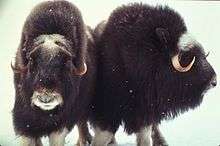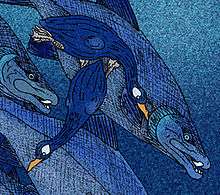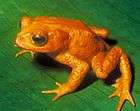Quaternary extinction event
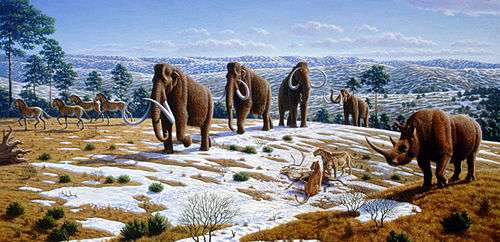
The Quaternary period saw the extinctions of numerous predominantly larger, especially megafaunal, species, many of which occurred during the transition from the Pleistocene to the Holocene epoch. However, this extinction wave did not stop at the end of the Pleistocene, but continued, especially on isolated islands, in human-caused extinctions, although there is debate as to whether these should be considered separate events or part of the same event.[1] Among the main causes hypothesized by paleontologists are natural climate change and overkill by humans,[2] who appeared during the Middle Pleistocene and migrated to many regions of the world during the Late Pleistocene and Holocene. A variant of the latter possibility is the second-order predation hypothesis, which focuses more on the indirect damage caused by overcompetition with nonhuman predators. The spread of disease is also discussed as a possible reason.
The Pleistocene or Ice Age extinction event
The Late Pleistocene extinction event saw the extinction of many mammals weighing more than 40 kg.
- In North America around 45 of 61 genera of large mammals became extinct.
- In South America 58 of 71
- In Australia 17 of 18
- In Europe 21 of 37
- In Asia 24 of 46
- In Subsaharan Africa only 8 of 50
The extinctions in the Americas entailed the elimination of all the larger (over 1000 kg) mammalian species of South American origin, including those that had migrated north in the Great American Interchange. Only in North America, South America, and Australia, did the extinction occur at family taxonomic levels or higher.
There are three main hypotheses concerning the Pleistocene extinction:
- The animals died off due to climate change associated with the advance and retreat of major ice caps or ice sheets.
- The animals were exterminated by humans: the "prehistoric overkill hypothesis" (Martin, 1967).[3]
- The extinction of the woolly mammoth (by whatever cause, perhaps by humans) changed the extensive grasslands to birch forests, and subsequent forest fires then changed the climate.[4] We now know that immediately after the extinction of the mammoth that birch forests replaced the grasslands and that an era of significant fire began.[5]
There are some inconsistencies between the current available data and the prehistoric overkill hypothesis. For instance, there are ambiguities around the timing of sudden extinctions of Australian megafauna.[3] Biologists note that comparable extinctions have not occurred in Africa and South or Southeast Asia, where the fauna evolved with hominids. Post-glacial megafaunal extinctions in Africa have been spaced over a longer interval.
Evidence supporting the prehistoric overkill hypothesis includes the persistence of certain island megafauna for several millennia past the disappearance of their continental cousins. Ground sloths survived on the Antilles long after North and South American ground sloths were extinct. The later disappearance of the island species correlates with the later colonization of these islands by humans. Similarly, dwarf woolly mammoths died out on remote Wrangel Island 1,000 years after their extinction on the mainland. Steller's sea cows also persisted in seas off the isolated and uninhabited Commander Islands for thousands of years after they had vanished from the continental shores of the north Pacific.[6]
Alternative hypotheses to the theory of human responsibility include climate change associated with the last glacial period and the Younger Dryas event, as well as Tollmann's hypothetical bolide, which claim that the extinctions resulted from bolide impact(s). Such a scenario has been proposed as a contributing cause of the 1,300 year cold period known as the Younger Dryas stadial. This impact extinction hypothesis is still in debate due to the exacting field techniques required to extract minuscule particles of extra terrestrial impact markers such as Iridium at a high resolution from very thin strata in a repeatable fashion, as is necessary to conclusively distinguish the event peak from the local background level of the marker. The debate seems to be exacerbated by infighting between the Uniformitarianism camp and the Catastrophism camp.

Africa and Asia
The Old World tropics have been relatively spared by Pleistocene extinctions. Africa and southern Asia are the only regions that have terrestrial mammals weighing over 1000 kg today. However, during the early, middle and late Pleistocene some large animal forms disappeared from these regions without being replaced by comparable successor species. Climate change has been cited as most likely causing the extinctions in Southeast Asia.[7]


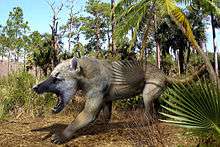

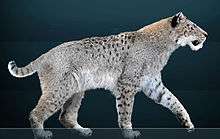


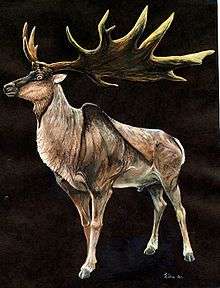
_-_Mauricio_Ant%C3%B3n.jpg)

Megafauna that disappeared in Africa or Asia during the Pleistocene include:
- Various giraffids (e.g. Giraffa jumae; Giraffa extirpated in Asia during the Middle Pleistocene)[8]
- Paracamelus
- Camelus moreli
- Soergelia
- Damalops
- Parmularius
- Various Gazella sp.[9] (e.g. Gazella psolea)
- Makapania
- Dubois’ antelope (Dubosia santeng[10]
- Bos acutifrons
- Chalicotheres (e.g. Ancylotherium, Nestoritherium)
- A few species of warthog such as Metridiochoerus
- Kolpochoerus
- Trogontherium
- Hippopotamus gorgops (a giant hippopotamus)
- Serengetilagus[11]
- Various members of Equidae
- Assorted members of Cervidae
- Broad fronted moose (Cervalces latifrons)
- Cervavitus
- Eucladoceros
- Libralces
- Praemegaceros
- Various members of the order Proboscidea
- Metaxytherium
- Running hyena (Chasmaporthetes)
- Giant hyena (Pachycrocuta)
- Bear Dog (Amphicyon lydekkeri)
- Giant predatory bear (Agriotherium)
- Auvergne bear (Ursus minimus)
- Dwarf panda (Ailuropoda minor) et Ailuropoda wulingshanensis[15]
- Viverra leakeyi
- Canidae sp.
- Canis falconeri
- Lycaon sekowei
- Merriam's dog (Megacyon merriami)
- Xenocyon lycaonoides
- Giant cheetah (Acinonyx pardinensis)
- Owen's Panther (Puma pardoides)
- Saber-toothed cats (Machairodontinae)
- Dinofelis
- Hemimachairodus
- Homotherium (extirpated from Africa 1.5 mya)
- Machairodus
- Megantereon
- Metailurus
- Panthera sp.
- European jaguar (Panthera (onca) gombaszoegensis)
- Panthera palaeosinensis
- Wanhsien tiger (Panthera tigris acutidens)
- Trinil tiger (Panthera tigris trinilensis)
- Ngandong tiger (Panthera tigris soloensis)
- Panthera youngi
- Longdan tiger (Panthera zdanskyi)
- Crocodilia sp.
- Crocodylus sp.
- Crocodylus anthropophagus
- Kali Gedeh giant crocodile (Species inquirenda)[16]
- Crocodylus palaeindicus
- Crocodylus thorbjarnarsoni
- Euthecodon
- Gavialis bengawanicus[17]
- Rimasuchus
- Toyotamaphimeia
- Crocodylus sp.
- Giant ape Gigantopithecus
- Theropithecus brumpti et Theropithecus oswaldi
- Parapapio
- Paranthropus
- Australopithecus
- Various Homo sp.
- Pelagornithidae (e.g. Pelagornis)
Megafauna that disappeared in Africa and Asia during the Late Pleistocene:
- Steppe bison (Bison priscus)
- Aurochs (Bos primigenius)
- Bos palaesondaicus
- Cebu tamaraw (Bubalus cebuensis)
- Leptobos sp.
- Naemorhedus sumatraensis
- Giant hartebeest (Megalotragus)
- Dorcabune[18]
- Megalovis[19]
- Hippotragus gigas[20]
- Giant long-horned buffalo (Pelorovis)
- Irish elk (Megaloceros giganteus)
- Sinomegaceros[21]
- Various Gazella sp.[9]
- Rusingoryx
- Spirocerus sp. (e.g. S. kiakhtensis)[22]
- Equus mauritanicus[23]
- Hexaprotodon
- Sivatherium maurusium
- Giant tapir (Megatapirus)
- Giant pika (Ochotona whartoni)
- Aardvark (Orycteropus afer, extirpated in South Asia circa 13,000 BCE)[24][25]
- Various members of Proboscidea
- Loxodonta atlantica
- Stegodon
- Woolly Mammoth (Mammuthus primigenius)
- Elephas sp.
- Palaeoloxodon sp.
- Palaeoloxodon namadicus (largest land mammal on record)[26]
- Palaeoloxodon naumanni
- Palaeoloxodon recki
- Rhinocerotidae
- Ceratotherium mauritanicum
- Woolly rhinoceros (Coelodonta antiquitatis)
- Elasmotherium (Elasmotherium sibiricum)
- Rhinoceros philippinensis[27] et Rhinoceros sinensis, and the South Asian rhino (Rhinoceros sivalensis)
- Stephanorhinus sp. (e.g. Merk's and Narrow Nosed Rhinoceros)
- Eurasian cave lion (Panthera leo spelea)
- Sri Lanka lion (Panthera leo sinhaleyus)
- Homotherium
- Cave hyena (Crocuta crocuta spelaea)
- Megafaunal Wolves
- Various Ursus sp.
- Deninger's bear (Ursus deningeri)
- Etruscan bear (ancestor to both the cave bear and brown bear (Ursus etruscus))
- Pleistocene small cave bear (Ursus rossicus)
- Cave bear (Ursus spelaeus)
- Giant polar bear (Ursus maritimus tyrannus)
- Ailuropoda baconi
- Wild Horse (Equus sp.)
- Asian ostrich (Struthio asiaticus)
- Bennu Heron (Ardea bennuides)
- Hovacrex roberti
- Malagasy sheldgoose (Centrornis majori)
- Hipposideros besaoka
- Voay
- Aldabrachampsus
- Cylindrapsis
- Megalochelys (largest recorded giant tortoise in existence)
- Leptoptilos robustus
- Shiriyanetta hasegawai[28]
- Canary Islands Quail (Coturnix gomerae)
- Gallotia goliath
- Canariomys
- Long-legged bunting (Emberiza alcoveri)
- Pongo hooijeri
- Macaca anderssoni, Macaca jiangchuanensis and the Robust Macaque (Macaca robustus)
- Gorgopithecus
- Various Homo sp.
The Pacific (Australasia and Oceania)

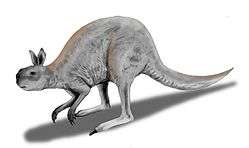
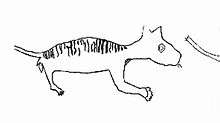

In Australia, the sudden spate of extinctions occurred earlier than in the Americas. Most evidence points to the period immediately after the first arrival of humans—thought to be a little under 50,000 years ago—but scientific argument continues as to the exact date range. In the rest of the Pacific (New Guinea, New Caledonia, the rest of Australasia and Oceania) although in some respects far later, endemic fauna also usually perished quickly upon the arrival of humans in the late Pleistocene and early Holocene This section does not include any spate of extinctions post 1000 BCE (e.g. subatlantic New Zealand or Hawaii).
The extinctions in the Pacific included:
- Various members of Diprotodontidae
- Diprotodon sp. (giant relatives of the wombats)
- Hulitherium tomasetti (a large marsupial herbivore)
- Maokopia ronaldi (diprotodont)
- Nototherium sp. (diprotodont)
- Zygomaturus sp. (a "marsupial rhino")
- Various members of Macropodidae
- Macropus sp. (e.g. M. titan, M.pearsoni, giant kangaroo)
- Procoptodon sp. ( e.g. P. goliath, hoof-toed, giant short-faced kangaroos)
- Propleopus oscillans (an omnivorous kangaroo)
- Protemnodon sp. (a form of giant wallaby)
- Simosthenurus sp. (a giant kangaroo)
- Sthenurus sp. (a giant kangaroo)
- Phascolonus sp. (a giant wombat)
- Palorchestes azael (a marsupial "tapir")
- Zaglossus hacketti (a giant echidna)
- Phascolarctos stirtoni (a giant koala)
- Megalibgwilia (oldest known echidna, same extinction period)
- Wonambi (a five-to-six-metre-long Australian constrictor snake)
- Thylacoleo carnifex (a lioness-sized marsupial carnivore)
- Thylacinus cynocephalus (extirpated on mainland Australia and New Guinea)
- Sarcophilus laniarius et Sarcophilus moornaensis (giant forms of the Tasmanian Devil)
- Varanus priscus (or Megalania prisca) (a giant predatory monitor lizard)
- Crocodilia sp.
- Ikanogavialis (the last fully marine crocodilian)
- Mekosuchus sp. (two meters long, last fully terrestrial crocodile, South Pacific Islands)
- Pallimnarchus sp. (a giant Australia freshwater crocodile)
- Quinkana sp. (a five-to-six metre-long terrestrial crocodile)
- Volia (a two-to-three meter long mekosuchine crocodylian, apex predator of Pleistocene Fiji)
- Meiolania et Ninjemys (giant armoured tortoises)
- Giant Iguana (Lapitiguana et Brachylophus gibbonsi)
- Genyornis newtoni (a three meter tall dromornthid, often referred to in vernacular as the 'last thunder bird')
- Powerful goshawk and the Gracile goshawk (Accipiter efficax et Accipiter quartus) [3]
- Sylviornis (giant, flightless New Caledonian galliform- largest in existence)
- Noble megapode (Megavitornis altirostris)
- New Caledonian gallinule (Porphyrio kukwiedei)
- Giant Megapodes
- Giant malleefowl (Leipoa gallinacea)
- Pile-builder megapode (Megapodius molistructor)
- Consumed scrubfowl (Megapodius alimentum)
- Viti Levu scrubfowl (Megapodius amissus)
- New Caledonian ground dove (Gallicolumba longitarsus)
- New Caledonian snipe et Viti Levu snipe (Coenocorypha miratropica et Coenocorypha neocaledonica)
- Niue night heron (Nycticorax kalavikai)
- Marquesas cuckoo-dove (Macropygia heana)
- New Caledonian Barn Owl (Tyto letocarti)
- Various Galliraillus sp.
- Kaua'i mole duck (Talpanas lippa, a blind, flightless, terrestrial Hawaiian duck)
- Apteribis (a giant, flightless ibis)
- Lowland kagu (Rhynochetos orarius)
- Viti Levu giant pigeon (Natunaornis gigoura)
- American Flamingo (Phoenicopterus ruber, extirpated in Australia)[29]
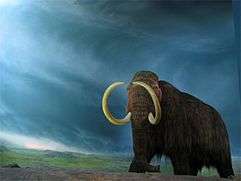 The woolly mammoth became extinct around 12,000 years ago – except a dwarf subspecies on Wrangel Island and St. Paul Island, which humans did not colonize until much later.
The woolly mammoth became extinct around 12,000 years ago – except a dwarf subspecies on Wrangel Island and St. Paul Island, which humans did not colonize until much later.
Some extinct megafauna, such as the bunyip-like Diprotodon, may remain in folk memory or be the sources of cryptozoological legends.
Europe and Northern Eurasia


.jpg)

(80,000–4,000 years ago)
- Woolly mammoth (Mammuthus primigenius)
- Dwarf Mammoth
- Cretan Dwarf Mammoth (Mammuthus creticus)
- Dwarf Sardinian Mammoth (Mammuthus lamarmorai)
- Straight Tusked Elephant (Palaeoloxodon antiquus)
- Dwarf Elephant
- Woolly rhinoceros (Coelodonta antiquitatis)
- Stephanorhinus sp. (e.g. Merk's and Narrow Nosed Rhinoceros)
- Elasmotherium (Elasmotherium sibiricum)
- Irish elk (Megaloceros giganteus)
- Praemegaceros
- Broad-fronted moose (Cervalces latifrons)
- Cretan dwarf megacerine (Candiacervus)
- Steppe bison (Bison priscus)
- Wild Horse (Equus sp. e.g. free ranging E. ferus caballus, European Ass (E. hydruntinus))
- Leptobos sp.
- Spirocerus kiakhtensis[22]
- Gazella sp.[9]
- Camelus knoblochi[30] and other Camelus sp.
- Balearic Islands cave goat ( Myotragus balearicus)
- Balearic giant dormouse (Hypnomys sp.)
- Leithia sp. (Maltese and Sicilian giant dormouse)[31]
- Hippopotamus sp.[32]
- European hippopotamus (Hippopotamus antiquus)
- Maltese Dwarf Hippopotamus (Hippopotamus melitensis)
- Cyprus Dwarf Hippopotamus (Hippopotamus minor)
- Sicilian Dwarf Hippopotamus (Hippopotamus petlandi)
- Robust Pleistocene European Otter (Cyrnaonyx)
- Pleistocene Mediterranean Otter (Algarolutra)
- Sardinian Giant Otter (Megalenhydris barbaricus)
- Sardinian Dwarf Otter (Sardolutra)
- European Ice Age Leopard (Panthera pardus spelaea)
- Sardinian Dhole (Cynotherium sardous)
- European Dhole (Cuon alpinus europaeus)
- Scimitar cat (Homotherium sp.)
- Lynx issiodorensis
- Mediterranean Cave Lynx (Lynx spelaeus)[33]
- Cave lion (Panthera leo spelaea)
- Cave hyena (Crocuta crocuta spelaea)
- Various Ursus sp.
- Etruscan bear (Ursus etruscus) (ancestor to both the cave bear and brown bear)
- Deninger's bear (Ursus deningeri)
- Gamssulzen Cave Bear (Ursus ingressus)[34]
- Pleistocene small cave bear (Ursus rossicus)
- Cave bear (Ursus spelaeus)
- Giant polar bear (Ursus maritimus tyrannus)
- Asian Ostrich (Struthio asiaticus)
- Giant Swan (Cygnus falconeri)
- Cretan Owl (Athene cretensis)
- Yakutian Goose (Anser djuktaiensis)
- Pleistocene European Cranes (Grus primigenia et Grus melitensis)
- Neanderthals (Homo neanderthalensis), survived until about 24,000 years ago in the Iberian peninsula.[35]
- Denisovians (Homo sp. altai)
 Ursus maritimus tyrannus restoration. Both the Tyrant polar bear and the present day polar bear (Ursus maritimus ssp.) occurred in Western Europe during the late Pleistocene.
Ursus maritimus tyrannus restoration. Both the Tyrant polar bear and the present day polar bear (Ursus maritimus ssp.) occurred in Western Europe during the late Pleistocene.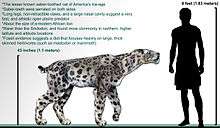 Homotherium serum restoration.
Homotherium serum restoration. Short faced bear (Arctodus simus)
Short faced bear (Arctodus simus)
Many extant species today were present in areas either far to the south or west to their current locations today- for example, the arctic fauna on this list all inhabited regions as south as Iberia. Species extirpated from portions of or all former ranges in Eurasia during the Quaternary Extinction Event include-
- European Lion (Panthera leo europaea)
- Fallow Deer (Dama dama)
- Wild Water Buffalo (Bubalus arnee)
- Onager (Equus hemionus)
- Saiga Antelope (Saiga tatarica)
- Polar Bear (Ursus maritimus)
- Arctic Fox (Vulpes lagopus)
- Dhole (Cuon alpinus)
- Gray Wolf (Megafaunal et Beringian wolf, and the Paleolithic dog (Canis lupus))
- Mouflon (Ovis orientalis orientalis)
- Northern Bald Ibis (Geronticus eremita)
- Musk ox (Ovibos moschatus)
- Aurochs (Bos primigenius)
- Hippopotamus (Hippopotamus amphibius)
- Wolverine (Gulo gulo)
- Persian Leopard (Panthera pardus ciscaucasica)
- Tarpan (Equus ferus ferus)
- Barbary Monkey (Macaca sylvanus)
- Reindeer (Rangifer tarandus)
- Eurasian and Iberian Lynx (Lynx lynx et Lynx pardinus)
- Chamois (Rupicapra spp.)
North America and the Caribbean

See also: List of North American animals extinct in the Holocene

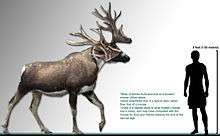
_1_(15257877377).jpg)
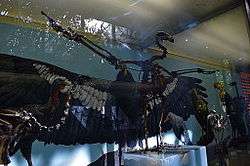


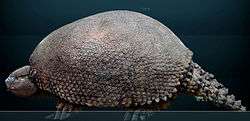



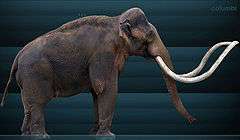
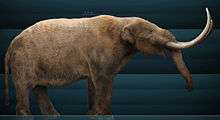
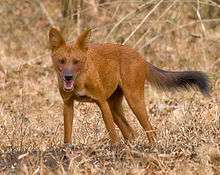
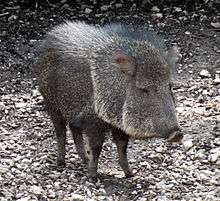



During the last 60,000 years, including the end of the last glacial period, approximately 51 genera of large mammals have become extinct in North America. Of these, many genera extinctions can be reliably attributed to a brief interval of 11,500 to 10,000 radiocarbon years before present, shortly following the arrival of the Clovis people in North America. Most other extinctions are poorly constrained in time, though some definitely occurred outside of this narrow interval.[37] In contrast, only about half a dozen small mammals disappeared during this time. Previous North American extinction pulses had occurred at the end of glaciations, but not with such an ecological imbalance between large mammals and small ones. (Moreover, previous extinction pulses were not comparable to the Quaternary extinction event; they involved primarily species replacements within ecological niches, while the latter event resulted in many ecological niches being left unoccupied.) The megafaunal extinctions include forty one genera of herbivores (H), and twenty carnivores (C). North American extinctions included:
- All forms of American wild horse (Equus) (H)
- Equus alaskae (H)
- Equus cedralensis (H)[38]
- Mexican horse (Equus conversidens) (H)
- Equus complicatus[39] (H)
- Stilt-legged horse (Equus francisci) (may be a synonym of Mexican horse) (H)
- Tarpan (Equus ferus ferus) (H)
- Equus fraternus (H)
- Equus giganteus[40] (H)
- Yukon wild ass (Equus lambei) (H)
- Equus mexicanus (H)[41]
- Pacific Horse (Equus pacificus)[42] (H)
- Western Horse (Equus occidentalis) (H)
- Equus semiplicatus (H)
- Hagerman horse (Equus simplicidens) (H)
- Scott's horse (Equus scotti) (H)
- All members of North American tapir (Tapirus, four species) (H)
- California tapir (Tapirus californicus) (H)
- Cope's tapir (Tapirus copei) (H)
- Merriam's tapir (Tapirus merriami) (H)
- Vero tapir (Tapirus veroensis) (H)
- Various members of Camelidae
- Western camel (Camelops hesternus) (H)
- Stilt legged llama (Hemiauchenia)(H)
- Stout legged llama (Paleolama) (H)
- Three of the last four Antilocapridae genera, only pronghorns survived) (H)
- Capromeryx (H)
- Stockoceros (H)
- Tetrameryx (H)
- American mountain deer (Odocoileus lucasi) (H)
- Stag-moose (Cervalces scotti) (H)
- Shrub-ox and Harlan's muskox (the Arctic Musk ox survived) (H)
- Harrington's mountain goat (Oreamnos harringtoni, smaller and more southern distribution than it's surviving relative) (H)
- Bison (only Bison bison in North America, and Bison bonasus in Eurasia, survived) (H)
- Ancient bison (Bison antiquus) (H)
- Long-horned/Giant bison (Bison latifrons) (H)
- Steppe bison (Bison priscus) (H)
- Bison occidentalis (H)
- Giant beaver (Castoroides ohioensis et Castoroides leiseyorum) (H)
- Aztlanolagus sp. (H)
- Saiga (Saiga tatarica, extirpated) (H)
- Giant tortoise (Hesperotestudo sp. et Gopherus donlaloi) (H)
- Teratorn (Teratornithidae) (C)
- Woodward's Eagle (Amplibuteo woodwardi) (C)
- Megafaunal Californian Condor (Gymnogyps amplus) (C)
- Cuban Condor (Gymnogyps varonai) (C)
- Breagyps sp. (C)
- Neogyps sp. (C)
- Puerto Rican crow (Corvus pumilis) (C)
- Cope's and Minute Flamingos (Phoenicopterus minutus et Phoenicopterus copei) (C)[43][44]
- Jamaican Ibis (Xenicibis xympithecus) (C)
- Caracara sp. (C)
- Milvago sp. (C)
- Cuban Giant Owl (Ornimegalonyx) (C)
- Neophrontops sp. (C)
- Daggett's eagle (Buteogallus daggetti) (C)
- Buteogallus fragilis (C)
- Buteogallus borrasi (C)
- La Brea/Asphalt Stork (Ciconia maltha) (C)
- Brea Owl (Oraristix brea) (C)
- Pleistocene Black Vulture (Coragyps occidentalis) (C)
- Titanohierax (C)
- Californian Flightless Sea Duck (Chendytes lawi) (C)
- Dow's Puffin (Fratercula dowi) (C)
- Bermuda flicker (Colaptes oceanicus)
- Nesotrochis sp. (e.g. Nesotrochis debooyi) (C)
- Barbados rail (Incertae sedis) (C)
- Cuban Flightless Crane (Grus cubensis) (H)
- La Brea Crane (Grus pagei) (H)
- Bermuda flightless duck (Anas pachyscelus) (H)
- Saint Croix Macaw (Ara autocthones) (H)
- Turkeys (Meleagris californica et Meleagris crassipes) (H)
- Sabertooth Salmon (Oncorhynchus rastrosus) (C)
- Pristine mustached bat (Pteronotus (Phyllodia) pristinus) (C)
- Antilles monkey (Xenotrichini) (H)
- Steller's Sea Cow (Hydrodamalis gigas, extirpated in North America) (H)
- Neochoerus (e.g. Pickney's capybara, N. pinckneyi) (H)
- Giant hutia (Heptaxodontidae) (H)
- Giant pika (Ochotona whartoni) (H)
- Eremotherium, a megatheriid ground sloths (H)
- Nothrotheriops and Nothrotherium, nothrotheriid ground sloths (H)
- Megalonyx, a megalonychid ground sloth (H)
- Paramylodon and Glossotherium, mylodontid ground sloths (H)
- Greater Antillean Dwarf Ground Sloths (Megalonychidae) (H)
- Acratocnus (H)
- Habanocnus (H)
- Megalocnus (H)
- Megalonyx (H)
- Miocnus (H)
- Neocnus (H)
- Various members of Glyptodontidae
- Glyptotherium (H)
- Doedicurus (H)
- Pachyarmatherium (H)
- Beautiful armadillo (Dasypus bellus)[45](H)
- Pampatheres (e.g. Holmesina) (H)
- Mixotoxodon[46][47] (H)
- Short-faced skunk (Brachyprotoma obtusata)[48] (C)
- Short-faced bear (Arctodus simus et Arctodus pristinus, one of the largest terrestrial mammal carnivores of all time) (C)
- Florida cave bear (Tremarctos floridanus) (C)
- Giant polar bear (Ursus maritimus tyrannus, it is possible that this giant relative of the modern polar bear lived in North America) (C)
- Homotherium (Homotherium serum) (C)
- Saber-toothed cat (Smilodon fatalis) (C)
- American cheetah (Miracinonyx, not a true cheetah) (C)
- American lion (Panthera leo atrox, endemic to North America after 340,000 BP) (C)
- Eurasian cave lion (Panthera leo spelea, present only as far as modern day Yukon) (C)
- Siberian tiger (Panthera tigris altaica, reached solely as far as the Yukon, extirpation date unknown)[49] (C)
- Pleistocene North American and South American Jaguars (Panthera onca augusta et Panthera onca mesembrina, range semi-recolonised by other subspecies) (C)
- Cougar (Puma concolor, megafaunal ecomorph extirpated from North America, South American populations recolonised former range) (C)
- Jaguarundi (Puma yagouaroundi, extirpated, range semi-recolonised) (C)
- Margay (Leopardus weidii, extirpated)(C)
- Ocelot (Leopardus pardalis, extirpated, range marginally recolonised) (C)
- Dhole (Cuon alpinus) (C)
- Various Canis sp.
- Dire wolf (Canis dirus) (C)
- Pleistocene coyote (Canis latrans orcutti)(C)
- Megafaunal wolf (e.g. Beringian wolf (Canis lupus)) (C)
- Gomphotheriidae sp. (H)
- Cuvieronius[50] (H)
- Stegomastodon[51] (H)
- Mammoth (Mammuthus) (H)
- Columbian mammoth (Mammuthus columbi) (H)
- Pygmy mammoth (Mammuthus exilis) (H)
- Woolly mammoth (Mammuthus primigenius) (H)
- American mastodon (Mammut americanum) (H)
- Flat-headed (Platygonus) and long-nosed (Mylohyus) peccaries (H)
- Collared peccary (Pecari tajacu, extirpated, range semi-recolonised) (H)
The survivors are in some ways as significant as the losses: bison (H), grey wolf (C), lynx (C), grizzly bear (C), American black bear (C), deer (e.g. caribou, moose, waipiti (elk), Odocoileus sp.) (H), pronghorn (H), white-lipped peccary (H), muskox (H), bighorn sheep (H), and mountain goat (H); the list of survivors also include species which were extirpated during the Quaternary extinction event, but recolonised at least part of their ranges during the mid-holocene from South American relict populations, such as the cougar (C), jaguar (C), collared peccary (H), ocelot (C), margay (C), and jaguarundi (C). All save the pronghorns descended from Asian ancestors that had evolved with human predators.[52] Pronghorns are the second fastest land mammal (after the cheetah), which may have helped them elude hunters. More difficult to explain in the context of overkill is the survival of bison, since these animals first appeared in North America less than 240,000 years ago[53][54][55] and so were geographically removed from human predators for a sizeable period of time. Because ancient bison evolved into living bison,[56][57] there was no continent-wide extinction of bison at the end of the Pleistocene (although the genus was regionally extirpated in many areas). The survival of bison into the Holocene and recent times is therefore inconsistent with the overkill scenario. By the end of the Pleistocene, when humans first entered North America, these large animals had been geographically separated from human hunters for more than 200,000 years. Given this enormous span of geologic time, bison would almost certainly have been very nearly as naive as native North American large mammals.
The culture that has been connected with the wave of extinctions in North America is the paleo-Indian culture associated with the Clovis people (q.v.), who were thought to use spear throwers to kill large animals. The chief criticism of the "prehistoric overkill hypothesis" has been that the human population at the time was too small and/or not sufficiently widespread geographically to have been capable of such ecologically significant impacts. This criticism does not mean that climate change scenarios explaining the extinction are automatically to be preferred by default, however, any more than weaknesses in climate change arguments can be taken as supporting overkill. Some form of a combination of both factors could be plausible, and overkill would be a lot easier to achieve large-scale extinction with an already dying population due to climate change.
Lack of tameable megafauna was perhaps one of the reasons why Amerindian civilizations evolved differently from Old World ones.[58] Critics have disputed this by arguing that llamas, alpacas, and bison were domesticated.[59]
South America
See also: List of South American animals extinct in the Holocene





South America had been isolated, an island continent, for many millions of years, and it had a wide range of fauna found nowhere else, though many of them became extinct during the Great American Interchange about 3 million years ago, such as the Phorusrhacidae and Saparassodonta families. Those that survived the interchange included the ground sloths, glyptodonts, pampatheres, and notoungulates; all managed to extend their range to North America. In the Pleistocene, South America remained largely unglaciated except for increased mountain glaciation in the Andes, with the megafauna were marginally affected. At the start of the Holocene, all the preeminent genera of megafauna became extinct. Their smaller relatives remain, including anteaters, tree sloths, armadillos; New World marsupials: opossums, shrew opossums, and the monito del monte (actually more related to Australian marsupials). Today the largest land mammals remaining in South America are the wild camels of the Lamini group, such as the guanacos and vicuñas, and the Tapirus genus, of which Baird's tapir can reach up to 400 kg. Other notable surviving large fauna are peccaries, marsh deer (Capreolinae), spectacled bears, maned wolves, pumas, ocelots, jaguars, rheas, emerald tree boas, boa constrictors, anacondas, american crocodiles, caimans, and giant rodents such as capybaras.
- Smilodon fatalis et Smilodon populator
- Panthera onca augusta et Panthera onca mesembrina
- Arctotherium
- Desmodus draculae
- Canis dirus
- Canis nehringi
- Theriodictis
- Protocyon
- Dusicyon avus et Dusicyon cultridens
- Speothos pacivorus
- Pachyarmatherium
- Dasypus bellus
- Antifer
- Agalmaceros[60][61]
- Camelidae
- Ground sloths
- Mylodontidae
- Megatheriidae
- Nothrotheriidae
- Megalonychidae
- Proplatyarthrus
- Valgipes gervais et Valgipes bucklandi[62]
- Glyptodontidae
- Doedicurus
- Eleutherocercus
- Glyptodon
- Heteroglyptodon[63]
- Hoplophorus
- Lomaphorus
- Neosclerocalyptus
- Neuryurus[64]
- Panochthus
- Parapanochthus[65]
- Plaxhaplous
- Sclerocalyptus
- Pampatheres (e.g. Holmesina, Pampetherium et Tonnicinctus)[66]
- Eutatus
- Propaopus[67]
- Neochoerus
- Equidae
- Toxodon
- Mixotoxodon
- Liptopterna
- Gomphotheridae
- Hegetotheriidae
- Mesotheriidae
- Milvago brodkorbi[68]
- Caiman venezuelensis
Later extinctions
There is no general agreement on where the Holocene, or anthropogenic, extinction begins, and the Quaternary extinction event which includes climate change resulting in the end of the last ice age ends, or if they should be considered separate events at all.[69][70] Some have suggested that anthropogenic extinctions may have begun as early as when the first modern humans spread out of Africa between 100,000 and 200,000 years ago, which is supported by rapid megafaunal extinction following recent human colonisation in Australia, New Zealand and Madagascar,[71] in a similar way that any large, adaptable predator moving into a new ecosystem would. In many cases, it is suggested even minimal hunting pressure was enough to wipe out large fauna, particularly on geographically isolated islands.[72][73] Only during the most recent parts of the extinction have plants also suffered large losses.[74]
Overall, the Holocene extinction can be characterised by the human impact on the environment. The Holocene extinction continues into the 21st century, with overfishing, ocean acidification and the amphibian crisis being a few broader examples of an almost universal, cosmopolitan decline of biodiversity.
Hunting hypothesis
The hunting hypothesis suggests that humans hunted megaherbivores to extinction, which in turn caused the extinction of carnivores and scavengers which had preyed upon those animals.[75][76][77] Therefore, this hypothesis holds Pleistocene humans responsible for the megafaunal extinction. One variant, known as blitzkrieg, portrays this process as relatvely quick. Some of the direct evidence for this includes: fossils of some megafauna found in conjunction with human remains, embedded arrows and tool cut marks found in megafaunal bones, and European cave paintings that depict such hunting. Biogeographical evidence is also suggestive: the areas of the world where humans evolved currently have more of their Pleistocene megafaunal diversity (the elephants and rhinos of Asia and Africa) compared to other areas such as Australia, the Americas, Madagascar and New Zealand without the earliest humans. A picture arises of the megafauna of Asia and Africa evolving alongside humans, learning to be wary of them, and in other parts of the world the wildlife appearing ecologically naive and easier to hunt. This is particularly true of island fauna, which display a disastrous lack of fear of humans. Of course, it is impossible to demonstrate this naïveté directly in ancient fauna.
Circumstantially, the close correlation in time between the appearance of humans in an area and extinction there provides weight for this scenario. For example, the woolly mammoth survived on islands despite changing climatic conditions for thousands of years after the end of the last glaciation, but they died out when humans arrived around 1700 BC. The megafaunal extinctions covered a vast period of time and highly variable climatic situations. The earliest extinctions in Australia were complete approximately 50,000 BP, well before the last glacial maximum and before rises in temperature. The most recent extinction in New Zealand was complete no earlier than 500 BP and during a period of cooling. In between these extremes megafaunal extinctions have occurred progressively in such places as North America, South America and Madagascar with no climatic commonality. The only common factor that can be ascertained is the arrival of humans.[78][79] This phenomenon appears even within regions. The mammal extinction wave in Australia about 50,000 years ago coincides not with known climatic changes, but with the arrival of humans. In addition, large mammal species like the giant kangaroo Protemnodon appear to have succumbed sooner on the Australian mainland than on Tasmania, which was colonised by humans a few thousand years later.[80][81]
Worldwide, extinctions seem to follow the migration of humans and to be most severe where humans arrived most recently and least severe where humans originated — in Africa (see figure "March of Man" below). This suggests that prey animals and human hunting ability evolved together, so the animals evolved avoidance techniques. As humans migrated throughout the world and became more and more proficient at hunting, they encountered animals that had evolved without the presence of humans. Lacking the fear of humans that African animals had developed, animals outside of Africa were easy prey for human hunting techniques. It also suggests that this is independent of climate change.
Extinction through human hunting has been supported by archaeological finds of mammoths with projectile points embedded in their skeletons, by observations of modern naïve animals allowing hunters to approach easily[82][83][84] and by computer models by Mosimann and Martin,[85] and Whittington and Dyke,[86] and most recently by Alroy.[87]
A 2015, a study supported the hypothesis further by running several thousand scenarios that correlated the time windows in which each species is known to have become extinct with the arrival of humans on different continents or islands.[88] This was compared against climate reconstructions for the last 90,000 years.[88] The researchers found correlations of human spread and species extinction indicating that the human impact was the main cause of the extinction, while climate change exacerbated the frequency of extinctions.[88][89] The study, however, found an apparently low extinction rate in the fossil record of mainland Asia.[89]
Overkill hypothesis

The overkill hypothesis, a variant of the hunting hypothesis, was proposed 40 years ago by Paul S. Martin, Professor of Geosciences Emeritus at the Desert Laboratory of the University of Arizona.
Objections to the hunting hypothesis
The major objections to the theory are as follows:
- In predator-prey models it is unlikely that predators could over-hunt their prey, since predators need their prey as food to sustain life and to reproduce.[90] This criticism has been rejected by many ecologists because humans have the widest dietary choice of any predator and are perfectly capable of switching to alternative prey or even plant foods when any prey species becomes rare. Humans have indisputably hunted numerous species to extinction, which renders any argument that human predators can never hunt prey to extinction immediately invalid.
- There is no archeological evidence that in North America megafauna other than mammoths, mastodons, gomphotheres and bison were hunted, despite the fact, that for example camels and horses are very frequently reported in fossil history.[91] Overkill proponents, however, say this is due to the fast extinction process in North America and the low probability of animals with signs of butchery to be preserved.[92] Additionally, biochemical analyses have shown that Clovis tools were used in butchering horses and camels.[93] A study by Surovell and Grund[94] concluded "archaeological sites dating to the time of the coexistence of humans and extinct fauna are rare. Those that preserve bone are considerably more rare, and of those, only a very few show unambiguous evidence of human hunting of any type of prey whatsoever."
- A small number of animals that were hunted, such as a single species of bison, did not go extinct. This cannot be explained by proposing that surviving bison in North America were recent Eurasian immigrants that were familiar with human hunting practices, since Bison first appeared in North America approximately 240,000 years ago[53][54][55] and then evolved into living bison.[56][95] Bison at the end of the Pleistocene were thus likely to have been almost as naive as their native North American megafaunal companions.
- The dwarfing of animals is not explained by overkill. Numerous authors, however, have pointed out that dwarfing of animals is perfectly well explained by humans selectively harvesting the largest animals, and have provided proof that even within the 20th century numerous animal populations have reduced in average size due to human hunting.
- Eurasian Pleistocene megafauna became extinct in roughly same time period despite having a much longer time to adapt to hunting pressure by humans. However, the extinction of the Eurasian megafauna can be viewed as a result of a different process than that of the American megafauna. This makes the theory less parsimonious since another mechanism is required. The latter case occurred after the sudden appearance of modern human hunters on a land mass they had never previously inhabited, while the former case was the culmination of the gradual northward movement of human hunters over thousands of years as their technology for enduring extreme cold and bringing down big game improved. Thus, while the hunting hypothesis does not necessarily predict the rough simultaneity of the north Eurasian and American megafaunal extinctions, this simultaneity cannot be regarded as evidence against it.
- Eugene S. Hunn points out that the birthrate in hunter-gatherer societies is generally too low, that too much effort is involved in the bringing down of a large animal by a hunting party, and that in order for hunter-gatherers to have brought about the extinction of megafauna simply by hunting them to death, an extraordinary amount of meat would have had to have been wasted.[96] It is possible that those who advocate the overkill hypothesis simply have not considered the differences in outlook between typical forager (hunter-gatherer) cultures and the present-day industrial cultures which exist in modernized human societies; waste may be tolerated and even encouraged in the latter, but is not so much in the former. It may be noted that in relatively recent human history, for instance, the Lakota of North America were known to take only as much bison as they could use, and they used virtually the whole animal—this despite having access to herds numbering in the millions.[97] Conversely, "buffalo jumps"[98] featured indiscriminate killing of a herd. However, Hunn's comments are in reference to a hunter-prey equilibrium state reached after thousands of years of coexistence, and are not relevant to hunters newly arrived on a virgin land mass full of easily taken big game. The well-established practice of industrial-scale moa butchering by the early Maori, involving enormous wastage of less choice portions of the meat, indicates that these arguments are incorrect.[82]
- The hypothesis that the Clovis culture represented the first humans to arrive in the New World has been disputed recently. (See Settlement of the Americas.) However, they were certainly the first to leave abundant widespread evidence of their presence.
Climate change hypothesis
At the end of the 19th and beginning of the 20th centuries, when scientists first realized that there had been glacial and interglacial ages, and that they were somehow associated with the prevalence or disappearance of certain animals, they surmised that the termination of the Pleistocene ice age might be an explanation for the extinctions.
Critics object that since there were multiple glacial advances and withdrawals in the evolutionary history of many of the megafauna, it is rather implausible that only after the last glacial would there be such extinctions. However, this criticism is rejected by a recent study indicating that terminal Pleistocene megafaunal community composition may have differed markedly from faunas present during earlier interglacials, particularly with respect to the great abundance and geographic extent of Pleistocene Bison at the end of the epoch.[99] This suggests that the survival of megafaunal populations during earlier interglacials is essentially irrelevant to the terminal Pleistocene extinction event, because bison were not present in similar abundance during any of the earlier interglacials.
Some evidence weighs against climate change as a valid hypothesis as applied to Australia. It has been shown that the prevailing climate at the time of extinction (40,000–50,000 BP) was similar to that of today, and that the extinct animals were strongly adapted to an arid climate. The evidence indicates that all of the extinctions took place in the same short time period, which was the time when humans entered the landscape. The main mechanism for extinction was probably fire (started by humans) in a then much less fire-adapted landscape. Isotopic evidence shows sudden changes in the diet of surviving species, which could correspond to the stress they experienced before extinction.[100][101][102]
Evidence in Southeast Asia, in contrast to Europe, Australia, and the Americas, suggests that climate change and an increasing sea level were significant factors in the extinction of several herbivorous species. Alterations in vegetation growth and new access routes for early humans and mammals to previously isolated, localized ecosystems were detrimental to select groups of fauna.[103]
Some evidence obtained from analysis of the tusks of mastodons from the American Great Lakes region appears inconsistent with the climate change hypothesis. Over a span of several thousand years prior to their extinction in the area, the mastodons show a trend of declining age at maturation. This is the opposite of what one would expect if they were experiencing stresses from deteriorating environmental conditions, but is consistent with a reduction in intraspecific competition that would result from a population being reduced by human hunting.[104]
Increased temperature
The most obvious change associated with the termination of an ice age is the increase in temperature. Between 15,000 BP and 10,000 BP, a 6 °C increase in global mean annual temperatures occurred. This was generally thought to be the cause of the extinctions.
According to this hypothesis, a temperature increase sufficient to melt the Wisconsin ice sheet could have placed enough thermal stress on cold-adapted mammals to cause them to die. Their heavy fur, which helps conserve body heat in the glacial cold, might have prevented the dumping of excess heat, causing the mammals to die of heat exhaustion. Large mammals, with their reduced surface area-to-volume ratio, would have fared worse than small mammals.
Arguments against the temperature hypothesis
More recent research has demonstrated that the annual mean temperature of the current interglacial that we have seen for the last 10,000 years is no higher than that of previous interglacials, yet some of the same large mammals survived similar temperature increases. Therefore, warmer temperatures alone may not be a sufficient explanation.[105][106][107][108][109][110]
In addition, numerous species such as mammoths on Wrangel Island[111] and St. Paul Island survived in human-free refugia despite changes in climate. This would not be expected if climate change were responsible (unless their maritime climates offered some protection against climate change not afforded to coastal populations on the mainland). Under normal ecological assumptions island populations should be more vulnerable to extinction due to climate change because of small populations and an inability to migrate to more favorable climes.
Increased continentality affects vegetation in time or space
Other scientists have proposed that increasingly extreme weather—hotter summers and colder winters—referred to as "continentality", or related changes in rainfall caused the extinctions. The various hypotheses are outlined below.
Vegetation changes: geographic
It has been shown that vegetation changed from mixed woodland-parkland to separate prairie and woodland.[107][108][110] This may have affected the kinds of food available. Shorter growing seasons may have caused the extinction of large herbivores and the dwarfing of many others. In this case, as observed, bison and other large ruminants would have fared better than horses, elephants and other monogastrics, because ruminants are able to extract more nutrition from limited quantities of high-fiber food and better able to deal with anti-herbivory toxins.[112][113][114] So, in general, when vegetation becomes more specialized, herbivores with less diet flexibility may be less able to find the mix of vegetation they need to sustain life and reproduce, within a given area.
Rainfall changes: time
Increased continentality resulted in reduced and less predictable rainfall limiting the availability of plants necessary for energy and nutrition.[115][116][117] Axelrod[118] and Slaughter[119] have suggested that this change in rainfall restricted the amount of time favorable for reproduction. This could disproportionately harm large animals, since they have longer, more inflexible mating periods, and so may have produced young at unfavorable seasons (i.e., when sufficient food, water, or shelter was unavailable because of shifts in the growing season). In contrast, small mammals, with their shorter life cycles, shorter reproductive cycles, and shorter gestation periods, could have adjusted to the increased unpredictability of the climate, both as individuals and as species which allowed them to synchronize their reproductive efforts with conditions favorable for offspring survival. If so, smaller mammals would have lost fewer offspring and would have been better able to repeat the reproductive effort when circumstances once more favored offspring survival.[120]
Arguments against the continentality hypotheses
Critics have identified a number of problems with the continentality hypotheses.
- Megaherbivores have prospered at other times of continental climate. For example, megaherbivores thrived in Pleistocene Siberia, which had and has a more continental climate than Pleistocene or modern (post-Pleistocene, interglacial) North America.[121][122][123]
- The animals that became extinct actually should have prospered during the shift from mixed woodland-parkland to prairie, because their primary food source, grass, was increasing rather than decreasing.[124][123][125] Although the vegetation did become more spatially specialized, the amount of prairie and grass available increased, which would have been good for horses and for mammoths, and yet they became extinct. This criticism ignores the increased abundance and broad geographic extent of Pleistocene Bison at the end of the Pleistocene, which would have increased competition for these resources in a manner not seen in any earlier interglacials.[99]
- Although horses became extinct in the New World, they were successfully reintroduced by the Spanish in the 16th century—into a modern post-Pleistocene, interglacial climate. Today there are feral horses still living in those same environments. They find a sufficient mix of food to avoid toxins, they extract enough nutrition from forage to reproduce effectively and the timing of their gestation is not an issue. Of course, this criticism ignores the obvious fact that present-day horses are not competing for resources with ground sloths, mammoths, mastodons, camels, llamas, and bison. Similarly, mammoths survived the Pleistocene Holocene transition on isolated, uninhabited islands in the Mediterranean Sea[126] and on Wrangel Island in the Siberian Arctic[127] until 4,000 to 7,000 years ago.
- Large mammals should have been able to migrate, permanently or seasonally, if they found the temperature too extreme, the breeding season too short, or the rainfall too sparse or unpredictable.[128] Seasons vary geographically. By migrating away from the equator, herbivores could have found areas with growing seasons more favorable for finding food and breeding successfully. Modern-day African elephants migrate during periods of drought to places where there is apt to be water.[129]
- Large animals store more fat in their bodies than do medium-sized animals[130] and this should have allowed them to compensate for extreme seasonal fluctuations in food availability.
The extinction of the megafauna could have caused the disappearance of the mammoth steppe. Alaska now has low nutrient soil unable to support bison, mammoths, and horses. R. Dale Guthrie has claimed this as a cause of the extinction of the megafauna there; however, he may be interpreting it backwards. The loss of large herbivores to break up the permafrost allows the cold soils that are unable to support large herbivores today. Today, in the arctic, where trucks have broken the permafrost grasses and diverse flora and fauna can be supported.[131][132] In addition, Chapin (Chapin 1980) showed that simply adding fertilizer to the soil in Alaska could make grasses grow again like they did in the era of the mammoth steppe. Possibly, the extinction of the megafauna and the corresponding loss of dung is what led to low nutrient levels in modern-day soil and therefore is why the landscape can no longer support megafauna.
Arguments against both climate change and overkill
It may be observed that neither the overkill nor the climate change hypotheses can fully explain events: browsers, mixed feeders and non-ruminant grazer species suffered most, while relatively more ruminant grazers survived. However, a broader variation of the overkill hypothesis may predict this, because changes in vegetation wrought by anthropogenic fire preferentially selects against browse species.
Hyperdisease hypothesis
Theory
The Hyperdisease Hypothesis attributes the extinction of large mammals during the late Pleistocene to indirect effects of the newly arrived aboriginal humans.[133][134][135] The Hyperdisease Hypothesis proposes that humans or animals traveling with them (e.g., chickens or domestic dogs) introduced one or more highly virulent diseases into vulnerable populations of native mammals, eventually causing extinctions. The extinction was biased toward larger-sized species because smaller species have greater resilience because of their life history traits (e.g., shorter gestation time, greater population sizes, etc.). Humans are thought to be the cause because other earlier immigrations of mammals into North America from Eurasia did not cause extinctions.[133]
Diseases imported by people have been responsible for extinctions in the recent past; for example, bringing avian malaria to Hawaii has had a major impact on the isolated birds of the island.
If a disease was indeed responsible for the end-Pleistocene extinctions, then there are several criteria it must satisfy (see Table 7.3 in MacPhee & Marx 1997). First, the pathogen must have a stable carrier state in a reservoir species. That is, it must be able to sustain itself in the environment when there are no susceptible hosts available to infect. Second, the pathogen must have a high infection rate, such that it is able to infect virtually all individuals of all ages and sexes encountered. Third, it must be extremely lethal, with a mortality rate of c. 50–75%. Finally, it must have the ability to infect multiple host species without posing a serious threat to humans. Humans may be infected, but the disease must not be highly lethal or able to cause an epidemic.
One suggestion is that pathogens were transmitted by the expanding humans via the domesticated dogs they brought with them.[136] Unfortunately for such a theory it can not account for several major extinction events, notably Australia and North America. Dogs did not arrive in Australia until approximately 35,000 years after the first humans arrived and approximately 30,000 years after the megafaunal extinction was complete and as such can not be implicated. In contrast numerous species including wolves, mammoths, camelids and horses had emigrated continually between Asia and North America over the past 100,000 years. For the disease hypothesis to be applicable in the case of the Americas it would require that the population remain immunologically naive despite this constant transmission of genetic and pathogenic material.
Arguments against the hyperdisease hypothesis
- Generally speaking, disease has to be very virulent to kill off all the individuals in a genus or species. Even such a virulent disease as West Nile Virus is unlikely to have caused extinction.[137]
- The disease would need to be implausibly selective while being simultaneously implausibly broad. Such a disease needs to be capable of killing off wolves such as Canis dirus or goats such as Oreamnos harringtoni while leaving other very similar species (Canis lupus and Oreamnos americanus, respectively) unaffected. It would need to be capable of killing off flightless birds while leaving closely related flighted species unaffected. Yet while remaining sufficiently selective to afflict only individual species within genera it must be capable of fatally infecting across such clades as birds, marsupials, placentals, testudines, and crocodilians. No disease with such a broad scope of fatal infectivity is known, much less one that remains simultaneously incapable of infecting numerous closely related species within those disparate clades.
Second-order predation


Scenario
The Second-Order Predation Hypothesis says that as humans entered the New World they continued their policy of killing predators, which had been successful in the Old World but because they were more efficient and because the fauna, both herbivores and carnivores, were more naive, they killed off enough carnivores to upset the ecological balance of the continent, causing overpopulation, environmental exhaustion, and environmental collapse. The hypothesis accounts for changes in animal, plant, and human populations.
The scenario is as follows:
- After the arrival of H. sapiens in the New World, existing predators must share the prey populations with this new predator. Because of this competition, populations of original, or first-order, predators cannot find enough food; they are in direct competition with humans.
- Second-order predation begins as humans begin to kill predators.
- Prey populations are no longer well controlled by predation. Killing of nonhuman predators by H. sapiens reduces their numbers to a point where these predators no longer regulate the size of the prey populations.
- Lack of regulation by first-order predators triggers boom-and-bust cycles in prey populations. Prey populations expand and consequently overgraze and over-browse the land. Soon the environment is no longer able to support them. As a result, many herbivores starve. Species that rely on the slowest recruiting food become extinct, followed by species that cannot extract the maximum benefit from every bit of their food.
- Boom-bust cycles in herbivore populations change the nature of the vegetative environment, with consequent climatic impacts on relative humidity and continentality. Through overgrazing and overbrowsing, mixed parkland becomes grassland, and climatic continentality increases.
Support
This has been supported by a computer model, the Pleistocene Extinction Model (PEM), which, using the same assumptions and values for all variables (herbivore population, herbivore recruitment rates, food needed per human, herbivore hunting rates, etc.) other than those for hunting of predators. It compares the Overkill hypothesis (predator hunting = 0) with Second-Order Predation (predator hunting varied between 0.01 and 0.05 for different runs). The findings are that Second Order-Predation is more consistent with extinction than is Overkill[138][139] (results graph at left).
The PEM is the only test of multiple hypotheses and is the only model to specifically test combination hypotheses by artificially introducing sufficient climate change to cause extinction. When Overkill and Climate Change are combined they balance each other out. Climate Change reduces the number of plants, Overkill removes animals, therefore fewer plants are eaten. Second-Order Predation combined with Climate Change exacerbates the effect of Climate Change.[140] (results graph at right).
The second-order predation hypothesis is supported by the observation above that there was a massive increase in bison populations.[141]
Second-order predation and other theories
- Climate Change: Second-Order Predation accounts for the changes in vegetation, which in turn may account for the increase in continentality. Since the extinction is due to destruction of habitat it accounts for the loss of animals not hunted by humans. Second-Order Predation accounts for the dwarfing of animals as well as extinctions since animals that could survive and reproduce on less food would be selectively favored.
- Hyperdisease: The reduction of carnivores could have been from distemper or other carnivore disease carried by domestic dogs.
- Overkill: The observation that extinctions follow the arrival of humans is consistent with the Second-Order Predation hypothesis.
Arguments against the second-order predation hypothesis
- The model specifically assumes high extinction rates in grasslands, but most extinct species ranged across numerous vegetation zones. Historical population densities of ungulates were very high in the Great Plains; savanna environments support high ungulate diversity throughout Africa, and extinction intensity was equally severe in forested environments.
- It is unable to explain why large herbivore populations were not regulated by surviving carnivores such as grizzly bears, wolves, pumas, and jaguars whose populations would have increased rapidly in response to the loss of competitors.
- It does not explain why almost all extinct carnivores were large herbivore specialists such as sabre toothed cats and short faced bears, but most hypocarnivores and generalized carnivores survived.
- There is no historical evidence of boom and bust cycles causing even local extinctions in regions where large mammal predators have been driven extinct by hunting. The recent hunting out of remaining predators throughout most of the United States has not caused massive vegetational change or dramatic boom and bust cycles in ungulates.
- It is not spatially explicit and does not track predator and prey species separately, whereas the multispecies overkill model does both.
- The multispecies model produces a mass extinction through indirect competition between herbivore species: small species with high reproductive rates subsidize predation on large species with low reproductive rates.[87] All prey species are lumped in the Pleistocene Extinction Model.
- Everything explained by the Pleistocene Extinction Model also is explained by the multispecies model, but with fewer assumptions, so the Pleistocene Extinction Model appears less parsimonious. However, the multispecies model does not explain shifts in vegetation, nor is it able to simulate alternative hypotheses. The multispecies model therefore necessitates additional assumptions and hence is less parsimonious.
Arguments against the second-order predation plus climate hypothesis
- It assumes decreases in vegetation due to climate change, but deglaciation doubled the habitable area of North America.
- Any vegetational changes that did occur failed to cause almost any extinctions of small vertebrates, and they are more narrowly distributed on average.
Comet hypothesis
First publicly presented at the Spring 2007 joint assembly of the American Geophysical Union in Acapulco, Mexico, the comet hypothesis suggests that the mass extinction was caused by a swarm of comets 12,900 years ago. Using photomicrograph analysis, research published in January 2009 has found evidence of nanodiamonds in the soil from six sites across North America including Arizona, Minnesota, Oklahoma, South Carolina and two Canadian sites. Similar research found nanodiamonds in the Greenland ice sheet.[142][143][144]
Arguments against the comet hypothesis
Debate around this hypothesis has included, among other things, the lack of an impact crater, relatively small increased level of iridium in the soil, and the relative probability of such an event.
- There is a lack of evidence for a population decline among the Paleoindians at 12,900 ± 100 calBP as might be expected.[145][146]
- There is evidence that the megafaunal extinctions that occurred across northern Eurasia, North America and South America at the end of the Pleistocene were not synchronous as the bolide theory would predict. The extinctions in South America appear to have occurred at least 400 years after those in North America.[147][148][149]
- Additionally, some island megafaunal populations survived thousands of years longer than populations of the same or related species on nearby continents; examples include the survival of woolly mammoths on Wrangel Island until 3700 BP,[147][148] and the survival of ground sloths in the Antilles until 4700 cal BP.[147][148][149]
- Several markers for the proposed impact event are disputed by most scientists. They have asserted that the carbon spherules originated as fungal structures and/or insect fecal pellets,[150] and that the claimed nanodiamonds are actually misidentified graphene and graphene/graphane oxide aggregates.[151][152] An analysis of a similar Younger Dryas boundary layer in Belgium also did not show evidence of a bolide impact.[153] Researchers have also not found any extraterrestrial platinum group metals in the boundary layer; this absence is inconsistent with the hypothesized impact event.[154]
See also
- Australian megafauna
- Late Quaternary prehistoric birds
- List of quaternary mammalian fauna of China
- Megafauna
- Pleistocene megafauna
- Pleistocene rewilding
- Toba catastrophe theory
References
- ↑ Kolbert, Elizabeth (2014). The Sixth Extinction: An Unnatural History. Bloomsbury Publishing. ISBN 9780805092998.
- ↑ Koch, Paul L.; Barnosky, Anthony D. (2006-01-01). "Late Quaternary Extinctions: State of the Debate". Annual Review of Ecology, Evolution, and Systematics. 37 (1): 215–250. doi:10.1146/annurev.ecolsys.34.011802.132415.
- 1 2 Gillespie, Richard (2008). "Updating Martin's global extinction model". Quaternary Science Reviews. 27 (27–28): 2522–2529. doi:10.1016/j.quascirev.2008.09.007.
- ↑ Donald K. Grayson, David J. Meltzer. 2002. Clovis Hunting and Large Mammal Extinction: A Critical Review of the Evidence. Journal of World Prehistory. December 2002, Volume 16, Issue 4, pp 313-359. http://link.springer.com/article/10.1023/A:1022912030020
- ↑ Geophysical Research Letters, Vol. 37, L15703, Biophysical feedbacks between the Pleistocene megafauna extinction and climate: The first human-induced global warming? Christopher E. Doughty, Adam Wolf, and Christopher B. Field.
- ↑ Anderson, Paul K. (July 1995). "Competition, Predation, and the Evolution and Extinction of Steller's Sea Cow, Hydrodamalis Gigas". Marine Mammal Science. Society for Marine Mammalogy. 11 (3): 391–4. doi:10.1111/j.1748-7692.1995.tb00294.x.
- ↑ Julien Louys; Darren Curnoe; Haowen Tong. (2007). "Characteristics of Pleistocene megafauna extinctions in Southeast Asia". Palaeogeography, Palaeoclimatology, Palaeoecology. 243: 152–173. doi:10.1016/j.palaeo.2006.07.011.
- ↑ Horowitz, Aharon (2014-05-10). The Quaternary of Israel. Academic Press. ISBN 9781483267234.
- 1 2 3 "Fossilworks: Gazella". fossilworks.org. Retrieved 2016-05-27.
- ↑ Rozzi, Roberto; Winkler, Daniela Eileen; De Vos, John; Schulz, Ellen; Palombo, Maria Rita (2013-05-01). "The enigmatic bovid Duboisia santeng (Dubois, 1891) from the Early–Middle Pleistocene of Java: A multiproxy approach to its paleoecology". Palaeogeography, Palaeoclimatology, Palaeoecology. 377: 73–85. doi:10.1016/j.palaeo.2013.03.012.
- ↑ "Fossilworks: Serengetilagus". fossilworks.org. Retrieved 2016-05-27.
- ↑ J, N, R, Shoshani, Goren-Inbar, Rabinovich (2001). "A stylohyoideum of Palaeoloxodon antiquus from Gesher Benot Ya'aqov, Israel: morphology and functional inferences" (PDF). The World of Elephants - International Congress, Rome 2001.
- ↑ Foronova, I. (2014). "Palaeoloxodon Elephant from the Pleistocene of Southwestern Siberia (Russia)" (PDF). Scientific Annals, School of Geology, Aristotle University of Thessaloniki, Greece, VIth International Conference on Mammoths and their Relatives, S.A.S.G., Special Volume 102: 59.
- ↑ "ECOLOGY AND EXTINCTION OF SOUTHEAST ASIA'S MEGAFAUNA". www.academia.edu. Retrieved 2016-05-29.
- ↑ "Fossilworks: Ailuropoda wulingshanensis". fossilworks.org. Retrieved 2016-05-02.
- ↑ Delfino, Massimo; De Vos, John (2014-03-01). "A giant crocodile in the Dubois Collection from the Pleistocene of Kali Gedeh (Java)". Integrative Zoology. 9 (2): 141–147. doi:10.1111/1749-4877.12065. ISSN 1749-4877. PMID 24673759.
- ↑ "Fossilworks: Gavialis bengawanicus". fossilworks.org. Retrieved 2016-05-23.
- ↑ "Fossilworks: Dorcabune". fossilworks.org. Retrieved 2016-05-29.
- ↑ "Fossilworks: Megalovis". fossilworks.org. Retrieved 2016-05-29.
- ↑ Clark, J. Desmond (1982-02-25). The Cambridge History of Africa. Cambridge University Press. ISBN 9780521222150.
- ↑ Geist, Valerius (1998-01-01). Deer of the World: Their Evolution, Behaviour, and Ecology. Stackpole Books. ISBN 9780811704960.
- 1 2 Hoffecker, John F.; Elias, Scott A. (2012-05-29). Human Ecology of Beringia. Columbia University Press. ISBN 9780231503884.
- ↑ Heinrich, Earl (31 October 2013). "Ancient Nubia" (PDF). Cambridge Online Histories.
- ↑ "Rock paintings show species that roamed India". www.newindianexpress.com. Retrieved 2016-09-14.
- ↑ Feldhamer, George A.; Drickamer, Lee C.; Vessey, Stephen H.; Merritt, Joseph F.; Krajewski, Carey (2015-01-01). Mammalogy: Adaptation, Diversity, Ecology. JHU Press. ISBN 9781421415888.
- ↑ Larramendi, Asier (2015). "Shoulder height, body mass and shape of proboscideans" (PDF). Acta Palaeontologica Polonica.
- ↑ "Fossilworks: Rhinoceros philippinensis". fossilworks.org. Retrieved 2016-04-28.
- ↑ Watanabe, Junya; Matsuoka, Hiroshige (2015-11-02). "Flightless diving duck (Aves, Anatidae) from the Pleistocene of Shiriya, northeast Japan". Journal of Vertebrate Paleontology. 35 (6): e994745. doi:10.1080/02724634.2014.994745. ISSN 0272-4634.
- ↑ Bayly, I. a. E. (1993-01-01). Hurlbert, Stuart H., ed. The fauna of athalassic saline waters in Australia and the Altiplano of South America: comparisons and historical perspectives. Developments in Hydrobiology. Springer Netherlands. pp. 225–231. doi:10.1007/978-94-011-2076-0_18. ISBN 9789401049214.
- ↑ "Habitat conditions for Camelus knoblochi and factors in its extinction by Vadim V. Titov" (PDF).
- ↑ "Search for images at Natural History Museum Picture Library". piclib.nhm.ac.uk. Retrieved 2016-04-20.
- ↑ Elias, Scott; Mock, Cary (2013-03-25). Encyclopedia of Quaternary Science. Newnes. ISBN 9780444536426.
- ↑ Ghezzo, Elena; Boscaini, Alberto; Madurell-Malapeira, Joan; Rook, Lorenzo (2014-12-16). "Lynx remains from the Pleistocene of Valdemino cave (Savona, Northwestern Italy), and the oldest occurrence of Lynx spelaeus (Carnivora, Felidae)". Rendiconti Lincei. 26 (2): 87–95. doi:10.1007/s12210-014-0363-4. ISSN 2037-4631.
- ↑ Münzel, Susanne C.; Rivals, Florent; Pacher, Martina; Döppes, Doris; Rabeder, Gernot; Conard, Nicholas J.; Bocherens, Hervé (2014-08-07). "Behavioural ecology of Late Pleistocene bears (Ursus spelaeus, Ursus ingressus): Insight from stable isotopes (C, N, O) and tooth microwear". Quaternary International. Fossil remains in karst and their role in reconstructing Quaternary paleoclimate and paleoenvironments. 339–340: 148–163. doi:10.1016/j.quaint.2013.10.020.
- ↑ Rincon, Paul (13 September 2006). "Neanderthals' 'last rock refuge'". BBC News. Retrieved 2009-10-11.
- ↑ Markova, A.K.; Puzachenko, A.Yu.; Kolfschoten, T. van; Kosintsev, P.A.; Kuznetsova, T.V.; Tikhonov, A.N.; Bachura, O.P.; Ponomarev, D.V.; Plicht, J. van der (2015-04-23). "Changes in the Eurasian distribution of the musk ox (Ovibos moschatus) and the extinct bison (Bison priscus) during the last 50 ka BP". Quaternary International. 378: 99–110. doi:10.1016/j.quaint.2015.01.020. ISSN 1040-6182.
- ↑ Anthony D. Barnosky; Paul L. Koch; Robert S. Feranec; Scott L. Wing; Alan B. Shabel (2004). "Assessing the Causes of Late Pleistocene Extinctions on the Continents". Science. 306 (5693): 70–75. Bibcode:2004Sci...306...70B. doi:10.1126/science.1101476. PMID 15459379.
- ↑ Teresa Alberdi, Arroyo-Cabrales, Marín-Leyva, Polaco, María, Joaquín, Alejandro H., and Oscar J. (April 28, 2014). "Study of Cedral Horses and their place in the Mexican Quaternary" (PDF). REVISTA MEXICANA DE CIENCIAS GEOLÓGICAS.
- ↑ "Fossilworks: Equus complicatus". fossilworks.org. Retrieved 2016-04-27.
- ↑ "Fossilworks: Equus giganteus". fossilworks.org. Retrieved 2016-04-27.
- ↑ Teresa Alberdi, Arroyo-Cabrales, Marín-Leyva, Alberdi Polaco, María, Joaquín, Alejandro H., and Oscar J. (April 28, 2014). "Study of Cedral Horses and their place in the Mexican Quaternary" (PDF). REVISTA MEXICANA DE CIENCIAS GEOLÓGICAS.
- ↑ "Fossilworks: Equus pacificus". fossilworks.org. Retrieved 2016-04-27.
- ↑ ondrej.zicha(at)gmail.com, Ondrej Zicha;. "BioLib: Biological library". www.biolib.cz. Retrieved 2016-04-12.
- ↑ "Fossilworks: Phoenicopterus copei". fossilworks.org. Retrieved 2016-04-12.
- ↑ McDonough, Colleen M.; Loughry, W. J. (2013-03-18). The Nine-Banded Armadillo: A Natural History. University of Oklahoma Press. ISBN 9780806189215.
- ↑ "The First Occurrence of a Toxodont (Mammalia, Notoungulata) in the United States". ResearchGate. doi:10.2307/23361085. Retrieved 2016-01-23.
- ↑ "A New Occurrence of Toxodonts in the Pleistocene of México". ResearchGate. Retrieved 2016-01-23.
- ↑ Youngman, Phillip M. (1986-03-01). "The extinct short-faced skunk Brachyprotoma obtusata (Mammalia, Carnivora): first records for Canada and Beringia". Canadian Journal of Earth Sciences. 23 (3): 419–424. doi:10.1139/e86-043. ISSN 0008-4077.
- ↑ Harington, Charles Richard; Nature, Canadian Museum of (2003-01-01). Annotated Bibliography of Quaternary Vertebrates of Northern North America: With Radiocarbon Dates. University of Toronto Press. ISBN 9780802048172.
- ↑ Sanchez, Guadalupe; Holliday, Vance T.; Gaines, Edmund P.; Arroyo-Cabrales, Joaquín; Martínez-Tagüeña, Natalia; Kowler, Andrew; Lange, Todd; Hodgins, Gregory W. L.; Mentzer, Susan M. (2014-07-29). "Human (Clovis)–gomphothere (Cuvieronius sp.) association ∼13,390 calibrated yBP in Sonora, Mexico". Proceedings of the National Academy of Sciences. 111 (30): 10972–10977. doi:10.1073/pnas.1404546111. ISSN 0027-8424. PMC 4121807
 . PMID 25024193.
. PMID 25024193. - ↑ Alberdi, María Teresa; Juárez-Woo, Javier; Polaco, Oscar J.; Arroyo-Cabrales, Joaquín (2009-02-01). "Description of the most complete skeleton of Stegomastodon (Mammalia, Gomphotheriidae) recorded for the Mexican Late Pleistocene". Neues Jahrbuch für Geologie und Paläontologie - Abhandlungen. 251 (2): 239–255. doi:10.1127/0077-7749/2009/0251-0239.
- ↑ MacPhee, RDE (1999). Extinctions in Near Time: Causes, Contexts, and Consequences. Kluwer Academic Publishers. ISBN 0-306-46092-0.
- 1 2 Bell, C.J.; et al. (2004). "The Blancan, Irvingtonian, and Rancholabrean mammal ages". In Woodburne, M.O. Late Cretaceous and Cenozoic Mammals of North America: Biostratigraphy and Geochronology. New York: Columbia Univ. Press. pp. 232–314. ISBN 0-231-13040-6.
- 1 2 Scott, E., Cox, S.M. (2008). "Late Pleistocene distribution of Bison (Mammalia; Artiodactyla) in the Mojave Desert of Southern California and Nevada". In Wang, X.; Barnes, L.G. Geology and Vertebrate Paleontology of Western and Southern North America. Los Angeles: Natural History Museum of Los Angeles County. pp. 359–382.
- 1 2 Sanders, A.E., R.E. Weems, and L.B. Albright III (2009). "Formalization of the mid-Pleistocene "Ten Mile Hill beds" in South Carolina with evidence for placement of the Irvingtonian–Rancholabrean boundary". In Albright III, L.B. Papers on Geology, Vertebrate Paleontology, and Biostratigraphy in Honor of Michael O. Woodburne. Flagstaff: Museum of Northern Arizona. pp. 369–375.
- 1 2 Shapiro, B.; et al. (2004). "Rise and Fall of the Beringian Steppe Bison". Science. 306 (5701): 1561–1565. Bibcode:2004Sci...306.1561S. doi:10.1126/science.1101074. PMID 15567864.
- ↑ Wilson, M.C., L.V. Hills, and B. Shapiro (2008). "Late Pleistocene northward-dispersing Bison antiquus from the Bighill Creek Formation, Gallelli Gravel Pit, Alberta, Canada, and the fate of Bison occidentalis". Canadian Journal of Earth Sciences. 45 (7): 827–859. Bibcode:2008CaJES..45..827W. doi:10.1139/E08-027.
- ↑ Diamond, J. (1997). Guns, Germs, and Steel: The Fates of Human Societies. WW Norton. ISBN 978-0-393-06131-4.
- ↑ Pielou, EC (1992). After the Ice Age: the return of life to glaciated North America. University of Chicago Press. ISBN 978-0-226-66812-3.
- ↑ "Fossilworks: Agalmaceros". fossilworks.org. Retrieved 2016-01-24.
- ↑ "Fossilworks: Agalmaceros blicki". fossilworks.org. Retrieved 2016-01-24.
- ↑ "Fossilworks: Valgipes". fossilworks.org. Retrieved 2016-01-24.
- ↑ Martin, Paul Schultz (2005-01-01). Twilight of the Mammoths: Ice Age Extinctions and the Rewilding of America. University of California Press. ISBN 9780520231412.
- ↑ "Fossilworks: Neuryurus". fossilworks.org. Retrieved 2016-01-24.
- ↑ "Fossilworks: Parapanochthus". fossilworks.org. Retrieved 2016-01-24.
- ↑ Góis, Flávio; Ruiz, Laureano Raúl González; Scillato-Yané, Gustavo Juan; Soibelzon, Esteban (2015-06-17). "A Peculiar New Pampatheriidae (Mammalia: Xenarthra: Cingulata) from the Pleistocene of Argentina and Comments on Pampatheriidae Diversity". PLOS ONE. 10 (6): e0128296. doi:10.1371/journal.pone.0128296. ISSN 1932-6203. PMC 4470999
 . PMID 26083486.
. PMID 26083486. - ↑ Elias, Scott; Mock, Cary (2013-03-25). Encyclopedia of Quaternary Science. Newnes. ISBN 9780444536426.
- ↑ "Fossilworks: Milvago brodkorbi". fossilworks.org. Retrieved 2016-04-22.
- ↑ Doughty, C. E.; Wolf, A.; Field, C. B. (2010). "Biophysical feedbacks between the Pleistocene megafauna extinction and climate: The first human‐induced global warming?". Geophys. Res. Lett. 37: L15703. Bibcode:2010GeoRL..3715703D. doi:10.1029/2010GL043985.
- ↑ Grayson, Donald K.; Meltzer, David J. (December 2012). "Clovis Hunting and Large Mammal Extinction: A Critical Review of the Evidence". Journal of World Prehistory. 16 (4): 313–359. doi:10.1023/A:1022912030020. Retrieved 20 April 2015.
- ↑ Kolbert, Elizabeth (2014). The Sixth Extinction: An Unnatural History. Bloomsbury Publishing. ISBN 9781408851210.
- ↑ Perry, George L. W.; Wheeler, Andrew B.; Wood, Jamie R.; Wilmshurst, Janet M. (2014-12-01). "A high-precision chronology for the rapid extinction of New Zealand moa (Aves, Dinornithiformes)". Quaternary Science Reviews. 105: 126–135. doi:10.1016/j.quascirev.2014.09.025.
- ↑ Crowley, Brooke E. (2010-09-01). "A refined chronology of prehistoric Madagascar and the demise of the megafauna". Quaternary Science Reviews. Special Theme: Case Studies of Neodymium Isotopes in Paleoceanography. 29 (19–20): 2591–2603. doi:10.1016/j.quascirev.2010.06.030.
- ↑ Li, Sophia. "Has Plant Life Reached Its Limits?". Green Blog. Retrieved 2016-01-22.
- ↑ Martin P. S. (1963). The last 10,000 years: A fossil pollen record of the American Southwest. Tucson, AZ: Univ. Ariz. Press. ISBN 0-8165-1759-2.
- ↑ Martin P. S. (1967). "Prehistoric overkill". In Martin, P.S.; Wright, H.E. Pleistocene extinctions: The search for a cause. New Haven: Yale Univ. Press. ISBN 0-300-00755-8.
- ↑ Martin P. S. (1989). "Prehistoric overkill: A global model". In Martin, P.S.; Klein, R.G. Quaternary extinctions: A prehistoric revolution. Tucson, AZ: Univ. Arizona Press. pp. 354–404. ISBN 0-8165-1100-4.
- ↑ Martin, P. S. (2005). Twilight of the Mammoths: Ice Age Extinctions and the Rewilding of America. University of California Press. ISBN 0-520-23141-4.
- ↑ Burney, D. A.; Flannery, T. F. (July 2005). "Fifty millennia of catastrophic extinctions after human contact" (PDF). Trends in Ecology & Evolution. Elsevier. 20 (7): 395–401. doi:10.1016/j.tree.2005.04.022. PMID 16701402.
- ↑ Diamond J (2008). "Palaeontology: The last giant kangaroo". Nature. 454 (7206): 835–6. Bibcode:2008Natur.454..835D. doi:10.1038/454835a. PMID 18704074.
- ↑ Turneya CS, Flannery TF, Roberts RG, Reid C, Fifield LK, Higham TF, Jacobs Z, Kemp N, Colhoun EA, Kalin RM, Ogle N (26 August 2008). "Late-surviving megafauna in Tasmania, Australia, implicate human involvement in their extinction". Proc. Natl. Acad. Sci. U.S.A. 105 (34): 12150–3. Bibcode:2008PNAS..10512150T. doi:10.1073/pnas.0801360105. PMC 2527880
 . PMID 18719103.
. PMID 18719103. - 1 2 Flannery, Tim (2002-10-16). The future eaters: an ecological history of the Australasian lands and people. New York: Grove/Atlantic, Inc. ISBN 0-8021-3943-4. OCLC 32745413.
- ↑ Diamond, J. (1984). "Historic extinctions: a Rosetta stone for understanding prehistoric extinctions". In Martin, P.S.; Klein, R.G. Quaternary extinctions: A prehistoric revolution. Tucson, AZ: Univ. Arizona Press. pp. 824–62. ISBN 0-8165-1100-4.
- ↑ Diamond, J. (1997). Guns, germs, and steel; the fates of human societies. New York: Norton. ISBN 0-393-31755-2.
- ↑ Mossiman, J. E. & Martin, P. S. (1975). "Simulating Overkill by Paleoindians". American Scientist. 63: 304–13. Bibcode:1975AmSci..63..304M.
- ↑ Whittington, S. L. & Dyke, B. (1984). "Simulating overkill: experiment with the Mossiman and Martin model". In Martin, P.S. & Klein, R.G. Quaternary extinctions: A prehistoric revolution. Tucson, AZ: Univ. Arizona Press. pp. 451–66. ISBN 0-8165-1100-4.
- 1 2 Alroy, J. (2001). "A multispecies overkill simulation of the end-Pleistocene megafaunal mass extinction" (PDF). Science. 292 (5523): 1893–6. Bibcode:2001Sci...292.1893A. doi:10.1126/science.1059342. PMID 11397940.
- 1 2 3 "Humans responsible for demise of gigantic ancient mammals". University of Exeter. 13 August 2015. Retrieved 14 August 2015.
- 1 2 Lewis J. Bartlett, David R. Williams, Graham W. Prescott, Andrew Balmford, Rhys E. Green, Anders Eriksson, Paul J. Valdes, Joy S. Singarayer, Andrea Manica. "Robustness despite uncertainty: regional climate data reveal the dominant role of humans in explaining global extinctions of Late Quaternary megafauna". Ecography. 39: 152–161. doi:10.1111/ecog.01566.
- ↑ May, R. M. (2001). Stability and complexity in model ecosystems. Princeton: Princeton Univ. Press. ISBN 0-691-08861-6.
- ↑ Grayson, D.K.; Meltzer, D.J. (2003). "A requiem for North American overkill". Journal of Archaeological Science. 30: 585–593. doi:10.1016/s0305-4403(02)00205-4.
- ↑ Fiedel, S., Haynes, G., 2004. A premature burial: comments on Grayson and Meltzer’s ‘‘Requiem for overkill’’ Journal of Archaeological Science 31, 121–131.
- ↑ Scott, J. (2009-02-26). "Camel-butchering in Boulder, 13,000 years ago". Colorado Arts and Sciences Magazine. University of Colorado at Boulder. Retrieved 2009-05-01. External link in
|work=(help) - ↑ Surovell, Todd A; Brigid S Grund (2012). "The associational critique of Quaternary overkill" (pdf). American Antiquity. 77 (4): 673–688. doi:10.7183/0002-7316.77.4.672. Retrieved 2013-02-19.
- ↑ Wilsom, M.C., L.V. Hills, and B. Shapiro (2008). "Late Pleistocene northward-dispersing Bison antiquus from the Bighill Creek Formation, Gallelli Gravel Pit, Alberta, Canada, and the fate of Bison occidentalis". Canadian Journal of Earth Sciences. 45 (7): 827–859. Bibcode:2008CaJES..45..827W. doi:10.1139/E08-027.
- ↑ Nadasdy, Paul (2006). "Transcending the Debate over the Ecologically Noble Indian: Indigenous Peoples and Environmentalism". Ethnohistory. 52 (2): 291–331. doi:10.1215/00141801-52-2-291.
- ↑ Svenson, Sally. "Bison." South Dakota Department of Game, Fish and Parks, 1995.
- ↑ "Buffalo Jump." Wikipedia.
- 1 2 Scott, E. (2010). "Extinctions, scenarios, and assumptions: Changes in latest Pleistocene large herbivore abundance and distribution in western North America". Quat. Int. 217: 225–239. Bibcode:2010QuInt.217..225S. doi:10.1016/j.quaint.2009.11.003.
- ↑ Willis, Paul; Bryce, Clay; Searle, Mike (17 August 2006). "Thylacoleo — The Beast of the Nullarbor". Catalysthttp://www.abc.net.au/catalyst/stories/s1717424.htm
|transcripturl=missing title (help). Australian Broadcasting Commission. - ↑ Prideaux GJ, Long JA, Ayliffe LK, et al. (January 2007). "An arid-adapted middle Pleistocene vertebrate fauna from south-central Australia". Nature. 445 (7126): 422–5. Bibcode:2007Natur.445..422P. doi:10.1038/nature05471. PMID 17251978.
- ↑ Roberts RG, Flannery TF, Ayliffe LK, et al. (June 2001). "New ages for the last Australian megafauna: continent-wide extinction about 46,000 years ago". Science. 292 (5523): 1888–92. Bibcode:2001Sci...292.1888R. doi:10.1126/science.1060264. PMID 11397939.
- ↑ Louys, Julien; Curnoe, D.; Tong, H. (2007). "Characteristics of Pleistocene megafauna extinctions in Southeast Asia". Palaeogeography, Palaeoclimatology, Palaeoecology. 243 (1-2): 152–173. doi:10.1016/j.palaeo.2006.07.011.
- ↑ Fisher, Daniel C. (2009). "Paleobiology and Extinction of Proboscideans in the Great Lakes Region of North America" (PDF). In Haynes, Gary. American Megafaunal Extinctions at the End of the Pleistocene. Springer. pp. 55–75. doi:10.1007/978-1-4020-8793-6_4. ISBN 978-1-4020-8792-9.
- ↑ Andersen, S. T (1973). "The differential pollen productivity of trees and its significance for the interpretation of a pollen diagram from a forested region". In Birks, H.J.B.; West, R.G. Quaternary plant ecology: the 14thsymposium of the British Ecological society, University of Cambridge, 28–30 March 1972. Oxford: Blackwell Scientific. ISBN 0-632-09120-7.
- ↑ Ashworth, C.A. (1980). "Environmental implications of a beetle assemblage from the Gervais formation (Early Wisconsinian?), Minnesota". Quat. Res. 13 (2): 200–12. Bibcode:1980QuRes..13..200A. doi:10.1016/0033-5894(80)90029-0.
- 1 2 Birks, H.H. (1973). "Modern macrofossil assemblages in lake sediments in Minnesota". In Birks, H.J.B.; West, R.G. Quaternary plant ecology: the 14thsymposium of the British Ecological Society, University of Cambridge, 28–30 March 1972. Oxford: Blackwell Scientific. ISBN 0-632-09120-7.
- 1 2 Birks, H.J.B., Birks, H.H. (1980). Quaternary paleoecology. Baltimore: Univ. Park Press. ISBN 1-930665-56-3.
- ↑ Bradley, R. S. (1985). Quaternary Paleoclimatology: Methods of Paleoclimatic Reconstruction. Winchester, MA: Allen & Unwin. ISBN 0-04-551068-7.
- 1 2 Davis, M. B. (1976). "Pleistocene biogeography of temperate deciduous forests". Geoscience and man: Ecology of the Pleistocene. 13. Baton Rouge: School of Geoscience, Louisiana State Univ.
- ↑ Vartanyan, S.L., Arslanov, K.A., Tertychnaya, T.V. & Chernov, S.B. (1995). "Radiocarbon dating evidence for mammoths on Wrangel Island, Arctic Ocean, until 2000 BC". Radiocarbon. 37: 1–6.
- ↑ Guthrie, R. D. (1988). Frozen Fauna of the Mammoth Steppe: The Story of Blue Babe. University Of Chicago Press. ISBN 0-226-31122-8.
- ↑ Guthrie, R. D. (1989). "Mosaics, allochemics, and nutrients: an ecological theory of Late Pleistocene megafaunal extinctions". In Martin, P.S.; Klein, R.G. Quaternary extinctions: A prehistoric revolution. Tucson, AZ: Univ. Arizona Press. pp. 259–99. ISBN 0-8165-1100-4.
- ↑ Hoppe, P.P. (1978). "Rumen fermentation in African ruminants". Proceedings of the 13th Annual Congress of Game Biologists. Atlanta.
- ↑ Bryson, R.A., Baerreis, D.A., Wendland, W.M. (1970). "The character of late-glacial and post-glacial climatic changes". In Dort Jr., W.; Jones, Jr. J.K. Pleistocene and recent environments of the central Great Plains. Lawrence: Univ. Press Kan. ISBN 0-7006-0063-9. Univ. Kan. Spec. Pub. 3.
- ↑ Graham, R.W., Lundelius, E.L. (1989). "Coevolutionary disequilibrium and Pleistocene extinctions". In Martin, P.S.; Klein, R.G. Quaternary extinctions: A prehistoric revolution. Tucson, AZ: Univ. Arizona Press. pp. 354–404. ISBN 0-8165-1100-4.
- ↑ King, J.E., Saunders, J.J. (1989). "Environmental insularity and the extinction of the American mastodont". In Martin, P.S.; Klein R.G. Quaternary extinctions: A prehistoric revolution. Tucson, AZ: Univ. Arizona Press. pp. 354–404. ISBN 0-8165-1100-4.
- ↑ Axelrod, D. I. (1967). "Quaternary extinctions of large mammals". University of California Publications in Geological Sciences. 74: 1–42. ASIN B0006BX8LG.
- ↑ Slaughter, B. H. (1967). "Animal ranges as a clue to late-Pleistocene extinction". In Martin, P.S.; Wright H.E. Pleistocene extinctions: The search for a cause. New Haven: Yale Univ. Press. ISBN 0-300-00755-8.
- ↑ Kilti, R. A. (1988). "Seasonality, gestation time, and large mammal extinctions". In Martin, P.S.; Klein R.G. Quaternary extinctions: A prehistoric revolution. Tucson, AZ: Univ. Arizona Press. pp. 354–404. ISBN 0-8165-1100-4.
- ↑ Flereov, C.C. (1967). "On the origin of the mammalian fauna of Canada". In Hopkins, D.M. The Bering Land Bridge. Palo Alto: Stanford Univ. Press. pp. 271–80. ISBN 0-8047-0272-1.
- ↑ Frenzel, B. (1968). "The Pleistocene vegetation of northern Eurasia". Science. 161 (3842): 637–49. Bibcode:1968Sci...161..637F. doi:10.1126/science.161.3842.637. PMID 17801456.
- 1 2 McDonald, J. (1989). "The reordered North American selection regime and late Quaternary megafaunal extinctions". In Martin, P.S.; Klein, R.G. Quaternary extinctions: A prehistoric revolution. Tucson, AZ: Univ. Arizona Press. pp. 354–404. ISBN 0-8165-1100-4.
- ↑ Birks, H.J.B., West, R.G. (1973). Quaternary plant ecology: the 14th symposium of the British Ecological society, University of Cambridge, 28–30 March 1972. Oxford: Blackwell Scientific. ISBN 0-632-09120-7.
- ↑ McDonald, J. (1981). North American Bison: Their classification and evolution. Berkeley: Univ. Calif. Press. ISBN 0-520-04002-3.
- ↑ Burney, D. A. (1993). "Recent animal extinctions: recipes for disaster". American Scientist. 81 (6): 530–41. Bibcode:1993AmSci..81..530B.
- ↑ Vartanyan, S.L., Garutt, V. E. and Sher, A.V. (1993). "Holocene dwarf mammoths from Wangel Island in the Siberian Arctic". Nature. 362 (6418): 337–40. Bibcode:1993Natur.362..337V. doi:10.1038/362337a0.
- ↑ Pennycuick, C.J. (1979). "Energy costs of locomotion and the concept of "Foraging radius"". In Sinclair A.R.E.; Norton-Griffiths M. Serengetti: Dynamics of an Ecosystem. Chicago: Univ. Chicago Press. pp. 164–85. ISBN 0-226-76029-4.
- ↑ Wing, L.D., Buss, I.O. (1970). "Elephants and Forests". Wildl. Mong. (19).
- ↑ Owen-Smith, R.N. (1992). Megaherbivores: The influence of very large body size on ecology. Cambridge studies in ecology. Cambridge: Cambridge Univ. Press. ISBN 0-521-42637-5.
- ↑ Kershaw, G.P. (1984). "Tundra plant communities of the Mackenzie mountains, Northwest Territories; floristic characteristics of long term surface disturbances". In Olson, R.; Hastings, R.; Geddes, F. Northern Ecology and Resource Management: Memorial Essays honoring Don Gill. Edmonton, Canada: Univ. Alberta Press. pp. 239–311. ISBN 0-88864-047-1.
- ↑ Webber, P.J., Miller, P.C., Chapin, F.S. III, MacCown, B.H. (1980). "The vegetation: pattern and succession". In Brown, J.; Miller, P.C.; Tieszen, L.L.; Bunnell, F.L. An Arctic ecosystem: the coastal tundra at Barrow, Alaska. US/IBP Synthesis. Stroudsburg, PA: Dowden Hutchinson & Ross. pp. 186–219. 12.
- 1 2 MacFee, R.D.E. & Marx, P.A. (1997). "Humans, hyperdisease and first-contact extinctions". In Goodman, S. & Patterson, B.D. Natural Change and Human Impact in Madagascar. Washington D.C.: Smithsonian Press. pp. 169–217. ISBN 1-56098-683-2.
- ↑ MacFee, R.D.E. & Marx, P.A. (1998). "Lightning Strikes Twice: Blitzkrieg, Hyperdisease, and Global Explanations of the Late Quaternary Catastrophic Extinctions". American Museum of Natural History.
- ↑ MacPhee, Ross D.E.; Preston Marx (1997). "The 40,000-year Plague: Humans, Hyperdisease, and First-Contact Extinctions". Natural Change and Human Impact in Madagascar. Washington, D.C.: Smithsonian Institution Press. pp. 169–217.
- ↑ Fiedel, S (2005). "Man's best friend: mammoth's worst enemy?". World Archaeology. 37: 11–35. doi:10.1080/0043824042000329540.
- ↑ Lyons, K, Smith, F.A., Wagner, P.J., White, E.P., and Brown, J.H. (2004). "Was a 'hyperdisease' responsible for the late Pleistocene megafaunal extinction?" (PDF). Ecology Letters. 7: 859–68. doi:10.1111/j.1461-0248.2004.00643.x.
- ↑ Whitney-Smith, E. (2004). "Late Pleistocene extinctions through second-order predation". In Barton, C.M.; Clark, G.A.; Yesner, D.R. Settlement of the American Continents: A Multidisciplinary Approach to Human Biogeography. Tucson, AZ: University of Arizona Press. ISBN 0-8165-2323-1.
- ↑ Whitney-Smith, E. (2009). The Second-Order Predation Hypothesis of Pleistocene Extinctions: A System Dynamics Model. Saarbruken, Germany: VDM Verlag. ISBN 978-3-639-11579-6.
- ↑ Whitney-Smith, E. (2006). Clovis and Extinctions – Overkill, Second Order Predation, Environmental Degradation in a Non-equilibrium Ecosystem "Clovis Age Continent". University of New Mexico Press.
- ↑ Scott, E. (2010). "Extinctions, scenarios, and assumptions: Changes in latest Pleistocene large herbivore abundance and distribution in western North America". Quat. Int.
- ↑ Study links mammoth extinction, comets, USA Today, Updated 1/2/2009 7:43 AM, retrieved 4 Apr 2009
- ↑ The Extinction Debate, by Evan Hadingham, NOVA, date retrieved 4 Apr 2009
- ↑ Last Extinction, NOVA, TV Program Description, Original PBS Broadcast Date: March 31, 2009, date retrieved 4 Apr 2009
- ↑ Buchanan B, Collard M, Edinborough K (19 August 2008). "Paleoindian demography and the extraterrestrial impact hypothesis". Proc. Natl. Acad. Sci. U.S.A. 105 (33): 11651–4. Bibcode:2008PNAS..10511651B. doi:10.1073/pnas.0803762105. PMC 2575318
 . PMID 18697936.
. PMID 18697936. - ↑ Haynes, Gary (2009). American megafaunal extinctions at the end of the Pleistocene. Springer. p. 125. ISBN 978-1-4020-8792-9.
- 1 2 3 Haynes, Gary (2009). "Introduction to the Volume". In Haynes, Gary. American Megafaunal Extinctions at the End of the Pleistocene. Springer. pp. 1–20. doi:10.1007/978-1-4020-8793-6_1. ISBN 978-1-4020-8792-9.
- 1 2 3 Fiedel, Stuart (2009). "Sudden Deaths: The Chronology of Terminal Pleistocene Megafaunal Extinction". In Haynes, Gary. American Megafaunal Extinctions at the End of the Pleistocene. Springer. pp. 21–37. doi:10.1007/978-1-4020-8793-6_2. ISBN 978-1-4020-8792-9.
- 1 2 Vergano, Dan (2009-01-02). "Study links mammoth extinction, comets". USA Today.Com. Gannett Company. Retrieved 2009-05-10. External link in
|work=(help) - ↑ Roach, John (2010-06-22). "Fungi, Feces Show Comet Didn't Kill Ice Age Mammals?". National Geographic Daily News. National Geographic Society. Retrieved 2010-06-25. External link in
|work=(help) - ↑ Daulton, T. L.; Pinter, N.; Scott, A. C. (2010-08-30). "No evidence of nanodiamonds in Younger–Dryas sediments to support an impact event". Proc. Natl. Acad. Sci. U.S.A. 107 (37): 16043–7. Bibcode:2010PNAS..10716043D. doi:10.1073/pnas.1003904107. PMC 2941276
 . PMID 20805511.
. PMID 20805511. - ↑ Kerr, Richard A. (2010-10-30). "Mammoth-Killer Impact Rejected". Science NOW. AAAS. Retrieved 2010-08-31. External link in
|work=(help) - ↑ Tian H, Schryvers D, Claeys P (January 2011). "Nanodiamonds do not provide unique evidence for a Younger Dryas impact". Proc. Natl. Acad. Sci. U.S.A. 108 (1): 40–4. Bibcode:2011PNAS..108...40T. doi:10.1073/pnas.1007695108. PMC 3017148
 . PMID 21173270.
. PMID 21173270. - ↑ Paquay FS, Goderis S, Ravizza G, et al. (December 2009). "Absence of geochemical evidence for an impact event at the Bølling-Allerød/Younger Dryas transition". Proc. Natl. Acad. Sci. U.S.A. 106 (51): 21505–10. Bibcode:2009PNAS..10621505P. doi:10.1073/pnas.0908874106. PMC 2799824
 . PMID 20007789.
. PMID 20007789.
External links
Hyperdisease hypothesis
- "American Museum of Natural History".
- J.H. Brown (University of New Mexico). "Was a hyperdisease responsible?" (PDF).
Second-order predation
- Elin Whitney-Smith. "Quaternary.Net".
Other links
- "Ice Age Bay Area".
- "The Extinct Late Pleistocene Mammals of North America".
- "End of the Big Beasts".
- "Of mice, mastodons and men: human-mediated extinctions on four continents" (PDF).
- "Return to the Ice Age: The La Brea Exploration Guide".
| Quaternary | ||
|---|---|---|
| Pleistocene | Holocene | |
| Early | Middle | Late | Preboreal | Boreal | Atlantic | Subboreal | Subatlantic | |
| Preceded by Proterozoic Eon | Phanerozoic Eon | |||||||||||
|---|---|---|---|---|---|---|---|---|---|---|---|---|
| Paleozoic Era | Mesozoic Era | Cenozoic Era | ||||||||||
| Cambrian | Ordovician | Silurian | Devonian | Carboniferous | Permian | Triassic | Jurassic | Cretaceous | Paleogene | Neogene | 4ry | |
